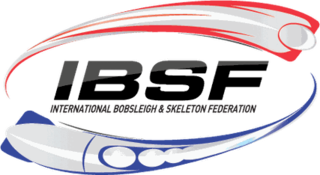
Bobsleigh or bobsled is a team winter sport that involves making timed runs down narrow, twisting, banked, iced tracks in a gravity-powered sleigh. International bobsleigh competitions are governed by the International Bobsleigh and Skeleton Federation, also known as FIBT from the French Fédération Internationale de Bobsleigh et de Tobogganing. National competitions are often governed by bodies such as the United States Bobsled and Skeleton Federation, Bobsleigh Canada Skeleton, and the German Bobsleigh, Luge, and Skeleton Federation.

The 1948 Winter Olympics, officially known as the V Olympic Winter Games and commonly known as St. Moritz 1948, were a winter multi-sport event held from 30 January to 8 February 1948 in St. Moritz, Switzerland. The Games were the first to be celebrated after World War II; it had been twelve years since the last Winter Games in 1936.

The 1928 Winter Olympics, officially known as the II Olympic Winter Games and commonly known as St. Moritz 1928, was an international winter multi-sport event that was celebrated from 11 to 19 February 1928 in St. Moritz, Switzerland.

Skeleton is a winter sliding sport in which a person rides a small sled, known as a skeleton bobsled, down a frozen track while lying face down and head-first. The sport and the sled may have been named from the bony appearance of the sled.

Sledding, sledging or sleighing is a winter sport typically carried out in a prone or seated position on a vehicle generically known as a sled, a sledge (British), or a sleigh. It is the basis of three Olympic sports: luge, skeleton and bobsledding. When practised on sand, it is known as a form of sandboarding. In Russia sledges are used for maritime activities including fishing and commuting from island to island on ice.

The Cresta Run is a natural ice skeleton racing toboggan track in eastern Switzerland. Located in the winter sports town of St. Moritz, the 1.2125 km (0.753 mi) run is one of the few in the world dedicated entirely to skeleton. It was built in 1884 near the hamlet of Cresta in the municipality of Celerina/Schlarigna by the Outdoor Amusement Committee of the Kulm Hotel and the people of St. Moritz. The committee members were Major William Henry Bulpett, George Robertson, Charles Digby Jones, C. Metcalfe, and J. Biddulph. It has continued as a partnership to this day between the SMTC, founded in 1887, and the people of St. Moritz.
Medals awarded for the skeleton discipline at the 1948 Winter Olympics held in St Moritz. At that time the sport was called cresta, and St. Moritz had the most famous Cresta Run, dating to 1884. In many locations the sport was referred to as tobogganing during these and the 1928 Games. The contest was run over a total of six runs.

Skeleton is a winter sport featured in the Winter Olympics where the competitor rides head-first and prone on a flat sled. It is normally run on an ice track that allows the sled to gain speed by gravity. It was first contested at the 1928 Winter Olympics in St. Moritz and again in 1948 Winter Olympics, after which it was discontinued as an Olympic sport. Skeleton was reintroduced at the 2002 Salt Lake City Olympics, with both men's and women's events, and has been held in each Winter Olympic competition since. Skeleton is so-named as the first metal sleds introduced in 1892 were said to resemble a human skeleton.

Sigmund Ruud was a Norwegian ski jumper. Together with his brothers Birger and Asbjørn, he dominated ski jumping in the 1920s and 1930s.

Switzerland was the host nation for the 1948 Winter Olympics in St. Moritz. It was the second time that Switzerland had hosted the Winter Games, after the 1928 Winter Olympics, also in St. Moritz.

The International Bobsleigh and Skeleton Federation (IBSF), originally known by the French name Fédération Internationale de Bobsleigh et de Tobogganing (FIBT), is the international sports federation for bobsleigh and skeleton. It acts as an umbrella organization for 14 national bobsleigh and skeleton associations as of 2007. It was founded on 23 November 1923 by the delegates of Great Britain, France, Switzerland, Canada, and the United States at the meeting of their first International Congress in Paris, France. In June 2015, it announced a name change from FIBT to IBSF. The federation's headquarters are in Lausanne, Switzerland.
The FIBT World Championships 1982 took place in St. Moritz, Switzerland for the record fourteenth time. The Swiss city had hosted the event previously in 1931 (Four-man), 1935 (Four-man), 1937 (Four-man), 1938 (Two-man), 1939 (Two-man), 1947, 1955, 1957, 1959, 1965, 1970, 1974, and 1977. The skeleton event debuted at the championships after being held in St. Moritz at the 1928 and 1948 Winter Olympics and it marked the first time the event took place on the actual bobsleigh track and not on the Cresta Run.

Jennison Heaton was an American bobsled and skeleton racer. He competed at the 1928 Winter Olympics and won a gold medal in the skeleton event and a silver in the five-man bobsleigh competition. In the skeleton, Heaton beat the silver medalist by one second. His other brother Trowbridge was also a bobsleigh enthusiast. Heaton later married Beulah Fiske, becoming the brother-in-law of Billy Fiske, also an Olympic bobsledder.
John Rutherford Heaton was an American bobsledder and skeleton racer who competed from the late 1920s to the late 1940s.
Farchild Maccarthy was born in Muskegon, Michigan was an American skeleton racer who competed in the late 1940s. He finished eighth in the men's skeleton event at the 1948 Winter Olympics in St. Moritz.
Skijoring was a demonstration sport at the 1928 Winter Olympics, held in St. Moritz, Switzerland from February 11 through 19, 1928. The sole skijoring event of the Games was held on February 12, the second day of the Games. The sport of skijoring is one in which a person on skis is pulled by dogs, horses, or a form of mechanized transportation such as a snowmobile. In the 1928 Olympics, athletes were towed behind horses.
For the 1948 Winter Olympics in St. Moritz, Switzerland, a total of eight sports venues were used. The five venues used for the 1928 Winter Olympics were reused for these games. Three new venues were added for alpine skiing which had been added to the Winter Olympics program twelve years earlier in Garmisch-Partenkirchen, Germany. As of 2015, the bob run continues to be used for bobsleigh and the Cresta Run for skeleton while alpine skiing remains popular in St. Moritz.











